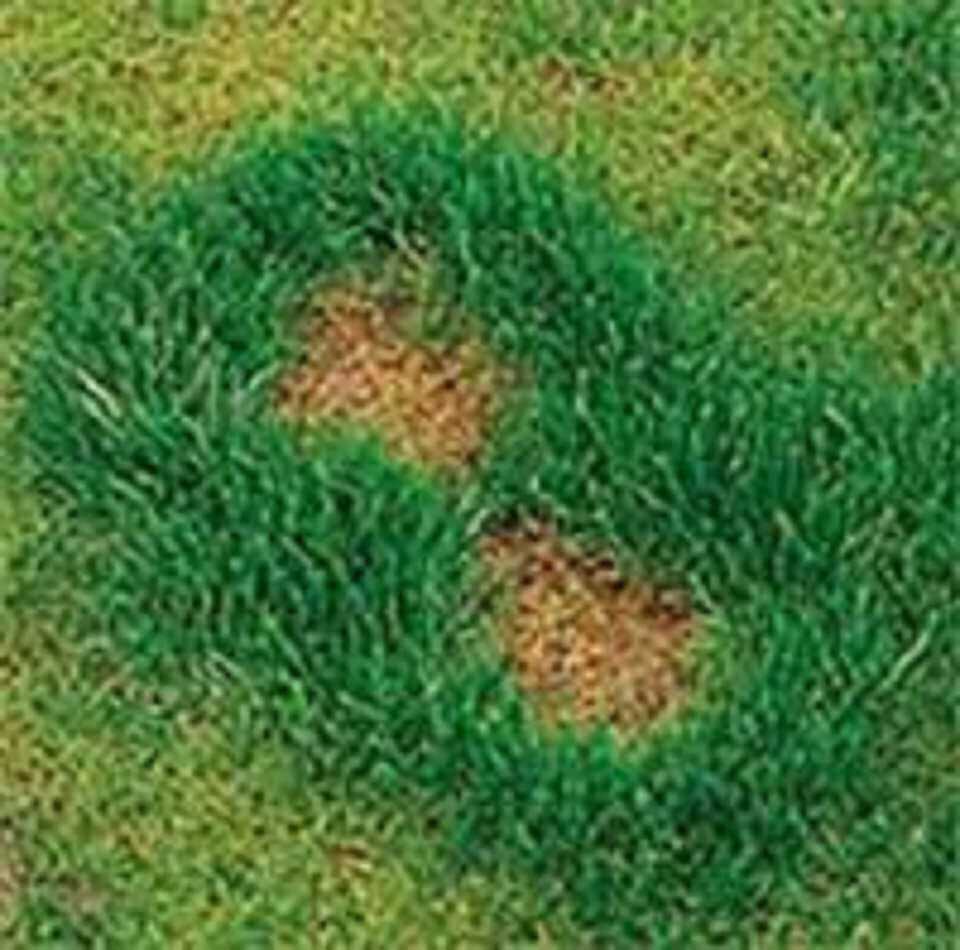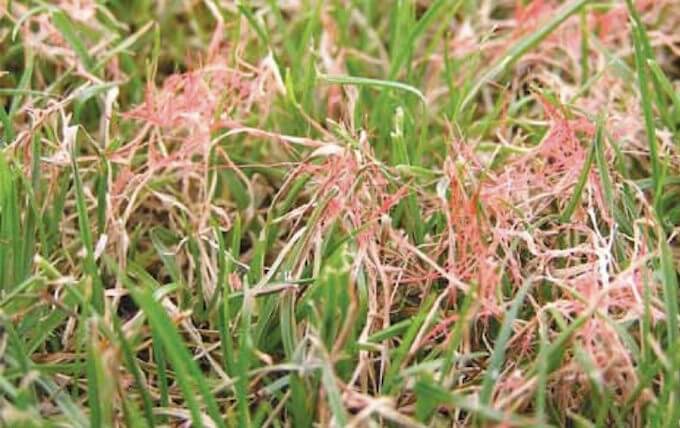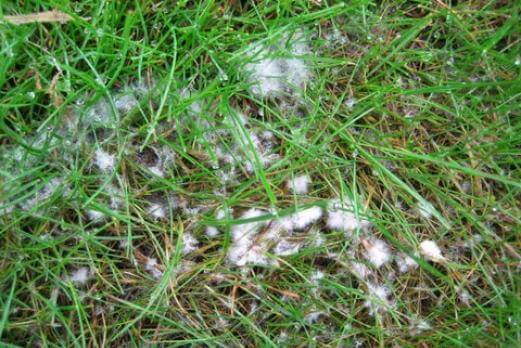What do lawn diseases look like?
If you are reading this blog, you’re probably already worried about your lawn. So lets decide first whether your lawn has fallen foul of a lawn disease or if something else has affected it.
If you have patches like this in your lawn, where a roughly circular brown area is surrounded by very dark green grass, its likely to be caused by pet urine rather than lawn diseases. More about pet urine here.

Redthread is a common lawn disease that tends to occur from mid to late summer. Uneven shaped patches of lawn take on a pinkish brown appearance and when you look closely you’ll see tiny pink strands of fungal mycellium.

Fusarium patch disease is characterised by circular patches of brown grass splattered with a slimy white fungus. It’s most active during a mild autumn or a warm wet spring.
What causes lawn diseases?
Before I start talking about controlling lawn diseases, I want to explain what causes them. I’m personally not a big fan of using chemical pesticides or fungicides on a lawn. I prefer to work with nature and manage disease by disturbing the life cycle of the pathogens. I don’t claim to be 100% organic with my treatments, but if there is an organic solution to a problem I’ll try that before I bring out the chemical sprays. Common lawn diseases like redthread, fusarium and anthracnose are caused by microscopic fungi.A little bit of lawn soil science
Soil is more than just dust and compost. It’s a whole living ecosystem on a microscopic scale. Every teaspoonful of garden soil contains more microbes and minibeasts than there are people on earth. There are bacteria, fungi, protozoa, nematodes, arthropods and earthworms. Most of the time we’re not even aware of them. But these amazing lifeforms go a long way to supporting life on earth. They are vital to our survival. Which is why I don’t want to use indiscriminate chemicals which will damage the good as well as the bad. In any ecosystem it doesn’t take much to change the balance of things. Take your insides for example. You’ll have seen those TV adverts for the little yoghurt drinks that are supposed to look after the good bacteria in your gut. The theory behind them is that in every system, there is a delicate balance between good elements and bad ones. If the good bacteria in your system are healthy, they can keep the bad ones under control. However, if you were to eat something that perhaps wasn’t as fresh as it could be, the balance in your gut might get disturbed. Drinking those yoghurt drinks won’t stop you getting a tummy upset – but if you have a healthy population of good bacteria, you’ll probably get over it quicker. It’s a similar situation in the soil beneath your lawn. There are good microbes and there are some that have the potential to cause problems for the grass. Most of the time, there are relatively few of the bad ones and so they don’t do any damage. In fact, they do a very useful job. They live in the thatch layer and feed off the leaves and roots, breaking them down and turning them into plant nutrients.How weather affects lawn diseases
However, if weather conditions are right, the microbes that have the potential to cause disease will multiply at great speed. They run out of dead stuff to feed on and so they start nourishing themselves with the living leaves. Large colonies of microbes are easy for us to see and they can harm the living plants. That simple imbalance in the ecosystem can cause visible damage to your lawn. It’s not your fault, it’s not my fault. Lawn diseases often occur as a result of changes in the weather and neither of us can control that. My job as a lawncare technician is to try to keep the soil ecosystem in balance and to make sure that the grass plants are strong and healthy so that an unavoidable dose of disease does minimal damage. I am to your lawn what those little yoghurt drinks are to your insides.Keeping the soil system in balance
Managing the soil is an all year round job. It’s similar to you maintaining your tummy’s health by keeping pathogens (disease causing microbes) under control in your home. You control pathogens by removing their food source and making the environment inhospitable for them ie washing worksurfaces, storing food at low temperatures and disposing of waste. I can’t control the temperature of your lawn but I can remove the food source for many of the pathogens that cause lawn diseases. I call it scarifying. The microbes that cause lawn diseases like to feed and breed in the thatch layer. Scarifying removes the thatch and helps me to keep the soil system in balance. The other way you may keep your digestive system healthy is to make sure you nourish the good microbes. I do that in your lawn by feeding the soil with nutrients that the good microbes like and need. That’s what lawn treatments are for. They nourish the soil microbes as well as the grass plants.Healthy grass plants resist disease and recover quicker
In my 25 or so years of working on golf courses and in the lawn care industry I couldn’t help but notice that when a grass sward is stressed it is more likely to succumb to disease. I suppose it’s no different to any of us. When we’re stressed or run down we seem to be more vulnerable to coughs and colds. My lawn care programs are designed to keep grass plants as healthy and well-nourished as they possibly can be. That’s no guarantee that they will resist every disease that mother nature challenges them with – but it certainly seems to increase their resistance. Plus the treatment is easier and the recovery time is quicker. Since introducing and organic seaweed tonic into the maintenance regime for some customers, I’ve noticed a definite reduction in attacks of redthread and fusarium patch. I hope that’s a trend that continues.How can you help to keep your lawn healthy?
My 5 top tips for a healthy lawn are- Don’t mow too low – a scalped lawn is more susceptible to disease
- Mow little and often – don’t let the grass grow long and then cut it really short. It’s too stressful for the plants
- Regular feeding
- Move lawn ornaments and toys every other day so that all the grass gets all the sunshine it possibly can
- Clear up autumn leaves as soon as they fall
- Scarify and aerate at least once a year to remove food for “bad” microbes and maintain the optimum soil structure for “good” soil microbes.
